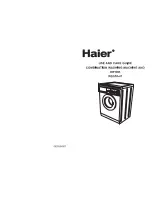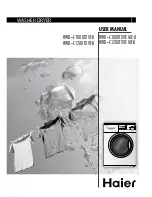
14
Vent System Chart
Number of
90° elbows
Type
of vent
Box/louvered
hoods
Angled
hoods
1
4
3
2
0
Rigid metal
Rigid metal
Rigid metal
Rigid metal
Rigid metal
64 ft. (20 m)
54 ft. (16.5 m)
44 ft. (13.4 m)
35 ft. (10.7 m)
27 ft. (8.2 m)
58 ft. (17.7 m)
48 ft. (14.6 m)
38 ft. (11.6 m)
29 ft. (8.8 m)
21 ft. (6.4 m)
The “Vent System Chart” provides venting requirements that
will help achieve best drying performance.
Special provisions for mobile homes:
Exhaust vent must be securely fastened to a noncombustible
portion of mobile home and must not terminate beneath the
mobile home. Terminate exhaust vent outside.
Determine vent path:
■
Select route that will provide straightest and most direct
path outdoors.
■
Plan installation to use fewest number of elbows and turns.
■
When using elbows or making turns, allow as much room
as possible.
■
Bend vent gradually to avoid kinking.
■
Use as few 90° turns as possible.
Determine vent length and elbows needed for best
drying performance:
■
Use the following “Vent System Chart” to determine type of
vent material and hood combinations acceptable to use.
NOTE:
Do not use vent runs longer than those specified
in “Vent System Chart”.
Exhaust systems longer than those specified will:
■
Shorten life of dryer.
■
Reduce performance, resulting in longer drying times
and increased energy usage.
Install Vent System
1.
Install exhaust hood
12" min.
(305 mm)
12" min.
(305 mm)
Install exhaust hood and use caulking compound to seal
exterior wall opening around exhaust hood.
NOTE:
Side and bottom exhaust installations have a 90° turn
inside the dryer. To determine maximum exhaust length, add
one 90° turn to the chart.
Optional exhaust installations:
This dryer can be converted to exhaust out the right side, left
side, or through the bottom. If you prefer, you may contact your
local dealer to have the dryer converted.
A. Standard rear offset exhaust installation
B. Left or right side exhaust installation
C. Bottom exhaust installation
A
B
C










































